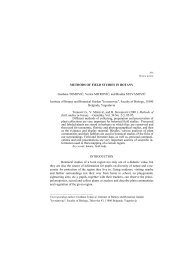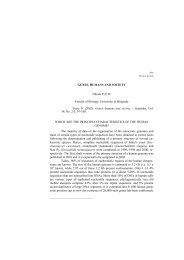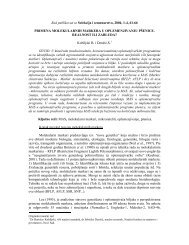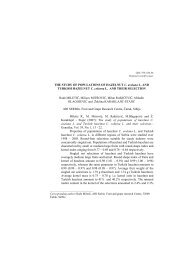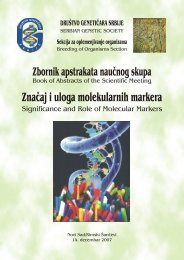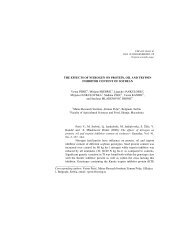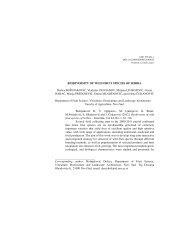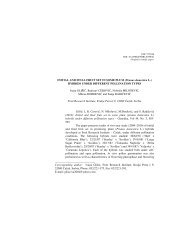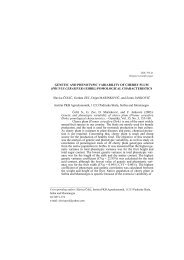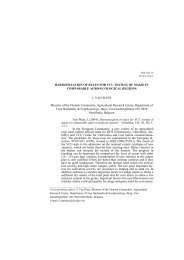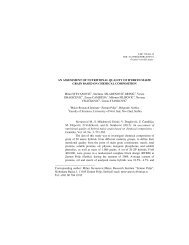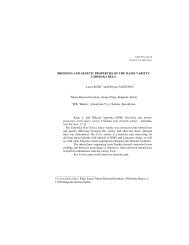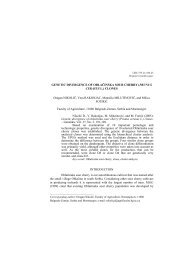Zbornik - Društvo genetičara Srbije
Zbornik - Društvo genetičara Srbije
Zbornik - Društvo genetičara Srbije
Create successful ePaper yourself
Turn your PDF publications into a flip-book with our unique Google optimized e-Paper software.
I-Uvo-2 ZBORNIK ABSTRAKATA III KONGRESA GENETIÈARA SRBIJE 9<br />
Subotica, 30. novembar - 4. decembar 2004.<br />
BIODIVERZITET DOMESTICIRANIH IVOTINJA<br />
S. Jovanoviæ, Ruica Trailoviæ i Mila Saviæ<br />
Katedra za stoèarstvo i genetiku, Fakultet veterinarske medicine, Beograd<br />
Uprkos velike raznovrsnosti ivotinjskog sveta samo èetrdesetak vrsta je domesticirano i<br />
gaji se u cilju zadovoljenja potreba razlièitih potreba èoveka. Domesticirani animalni<br />
biodiverzitet predstavlja spektar genetièke raznovrsnosti, koji ukljuèuje preko 6000<br />
razlièitih rasa od kojih svaka ima posebne karakteristike i namenu. Zbog intenzifikacije<br />
stoèarske proizvodnje tokom poslednjih vekova su selekcionirane specijalizovane, visokoproduktivne<br />
rase, koje potiskuju manje selekcionirane autohtone rase, tako da je samo<br />
u poslednjih 50 godina preko 65% rasa u svetu postalo ugroeno, a mnoge su išèezle.<br />
Autohtone rase domaæih ivotinja, nastale u toku dugotrajnog procesa evolucije, dobro<br />
prilagoðene datim uslovima gajenja, mogu u buduænosti predstavljati vaan izvor varijabilnosti<br />
za poboljšanje otpornosti visokoproduktivnih rasa. Zbog toga je u okviru prouèavanja<br />
i zaštite globalnog biodiverziteta, koje koordinira FAO i UNEP, ukljuèeno i<br />
prouèavanje i zaštita animalnih genetskih resursa gajenih vrsta ivotinja, koji mogu biti<br />
znaèajni u obnavljanju domesticiranog genofonda. Kljuèni element strategije oèuvanja<br />
animalnih resursa predstavlja genetièka karakterizacija rasa u cilju dobijanja kompletne slike<br />
genetièke varijabilnosti unutar svake vrste domaæih ivotinja. Opšte prihvaæeno mišljenje je<br />
da se merenjem genetske distance obezbeðuju trenutno najbolje informacije, koje omoguæavaju<br />
rangiranje rasa u okviru vrste. Zahvaljujuæi brzom razvoju tehnike za mapiranje i<br />
izolaciju gena, upotreba animalnih genetskih resursa u buduænosti æe biti zasnovana na<br />
identifikaciji gena koji su u vezi sa specifiènim fenotipskim karakteristikama.<br />
DOMESTIC ANIMAL BIODIVERSITY<br />
Although, the degree of diversity of animal species is extensive, only around 40 species<br />
had been domesticated and used to fullfill different human needs. Domesticated animal<br />
biodiversity represents a broad spectrum of genetic differences distributed among over<br />
6000 breeds of domesticated mamals and birds, each representing a unique set of genes.<br />
The intensification of animal production during the last centuries gave force to the selective<br />
breeding which resulted in the development of specialised, highly-producing breeds. The<br />
interest to breed less productive autochthonous breeds compared to high-producing ones is<br />
lost and the trend of erosion of genetic diversity is global. Only in last 50 years arround<br />
65% of catalogized breeds became endangered or vulnerable, and some are already extinct.<br />
Autochthonous breeds of domestic animals have resulted during long evolution directed<br />
by human demands and adaptation to the local environment, environmental changes and<br />
chalenges. Therefore they can serve as the source of variables for improvement of resistance<br />
in highly-selected breeds in unpredictable selective chalenges in future. This was<br />
the reason that introduced the evaluation and protection of the domesticated gene pool<br />
into the programme of the protection of the global biodiversitz coordinated by UNEP and<br />
FAO. The genetic characterization of the separate breeds in aim to fullfill tha data of genetic<br />
variability within each domesticated species is the key element of the conservation<br />
strategy. The wide accepted oppinion is that most comparable data can be obtained by<br />
evaluation of the genetic distance among breeds. Due to the development of the techniques<br />
for genetic mapping and isolation of the genes, one of the uses of domestic animal<br />
resources in the future would be based upon identification of the genes which are linked<br />
to favourable phenotypic character.



